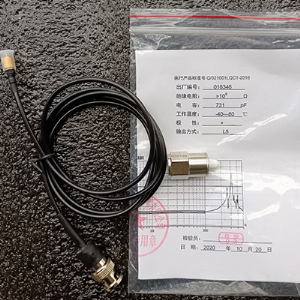Selection Factors for Vibration Sensors
Selection index of vibration acceleration sensor:
Sensor performance includes sensitivity, measurement range, vibration frequency, frequency response characteristics, linearity and lateral effects.
Measuring range: According to the specific situation, the range of the selected sensor is generally 10% to 30% larger than the upper limit of measurement.
Sensitivity: Large-range sensors have low sensitivity, while small-range sensors have high sensitivity. Usually, the upper limit of the sensor output voltage is 5V, so the sensitivity multiplied by the range is 5V (zero-frequency acceleration sensors and other types of sensors do not conform to the 2nd law).
Frequency response characteristics: The frequency response characteristics of the sensor determine the frequency range of the measurement, and the measurement conditions without distortion must be kept within the allowable frequency range. In fact, the response of the sensor always has a certain delay, and the shorter the delay time, the better.
Vibration frequency: the first-order natural frequency of the sensor, the operating frequency range of the sensor is less than 1\/3 of its own resonance frequency.
Linearity: The linear range of the sensor refers to the range in which the output is proportional to the input. Theoretically, within this range, the sensitivity remains unchanged. The wider the linear range of the sensor, the larger its range, which can guarantee a certain measurement accuracy. Select the sensor , after determining the sensor type, first check whether its range meets the requirements.
Lateral effect: The lower the sensitivity of the lateral effect, the better the performance. Generally speaking, the lateral effect is less than 5 percent.
Selection principles of vibration acceleration sensors:
1) The sensor type should be selected according to the matching with the subsequent equipment. For example, ICP adjustment equipment should use ICP sensors, and charging adjustment equipment should use piezoelectric sensors.
1) When measuring the structure to be tested under working conditions, an "isolated" sensor should be used. If the sensor itself is not isolated, an insulating material can be added to the bottom of the sensor as an isolation device.
2) The vibration amplitude at the measurement point should be 60% to 80% of the sensor range to ensure high signal-to-noise ratio and overload.
3) The operating frequency range of the selected sensor is slightly higher than the actual measured bandwidth.
4) According to environmental factors, such as the temperature and humidity of the measurement site, select the appropriate sensor. Make sure that the selected sensor can work normally and the measurement amplitude will not be affected.
5) Select the sensor size and outlet mode according to the space of the measurement location.
6) For lightweight structures, the influence of sensor weight on the measurement must be considered.
7) The sensor should be selected according to the industrial application. For example, the mechanical industry should choose a sensor with a large vibration amplitude and a wide frequency range, while the civil industry should choose a sensor with a small range, high sensitivity, and good low-frequency performance.
In short, when selecting a sensor, the above factors must be fully considered, the most suitable sensor should be selected for measurement, and the influence of the sensor itself on the test should be minimized.

Previous: Materials and constructions of piezoelectric sensors
下一条: No Information

